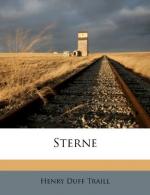[Footnote 1: “I was once such a puppy myself,” he writes to a certain baronet whom he is attempting to discourage from speculative farming of this sort, “and had my labour for my pains and two hundred pounds out of pocket. Curse on farming! (I said). Let us see if the pen will not succeed better than the spade.”]
[Footnote 2: He himself, indeed, makes a particular point of this in explaining his literary venture. “Now for your desire,” he writes to a correspondent in 1759, “of knowing the reason of my turning author? why, truly I am tired of employing my brains for other people’s advantage. ’Tis a foolish sacrifice I have made for some years for an ungrateful person.”—Letters, i. 82.]
All the world knows how far he ultimately advanced beyond the simplicity of the conception, and into what far higher regions of art its execution led him. But I find no convincing reason for believing that Tristram Shandy had at the outset any more seriously artistic purpose than this; and much indirect evidence that this, in fact, it was.
The humorous figure of Mr. Shandy is, of course, the Cervantic centre of the whole; and it was out of him and his crotchets that Sterne, no doubt, intended from the first to draw the materials of that often unsavoury fun which was to amuse the light-minded and scandalize the demure. But it can hardly escape notice that the two most elaborate portraits in Vol. I.—the admirable but very flatteringly idealized sketch of the author himself in Yorick, and the Gilrayesque caricature of Dr. Slop—are drawn with a distinctly polemical purpose, defensive in the former case and offensive in the latter. On the other hand, with the disappearance of Dr. Slop caricature of living persons disappears also; while, after the famous description of Yorick’s death-bed, we meet with no more attempts at self-vindication. It seems probable, therefore, that long before the first two volumes were completed Sterne had discovered the artistic possibilities of “My Uncle Toby” and “Corporal Trim,” and had realized the full potentialities of humour contained in the contrast between the two brothers Shandy. The very work of sharpening and deepening the outlines of this humorous antithesis, while it made the crack-brained philosopher more and more of a burlesque unreality, continually added new touches of life and nature to the lineaments of the simple-minded soldier; and it was by this curious and half-accidental process that there came to be added to the gallery of English fiction one of the most perfect and delightful portraits that it possesses.




